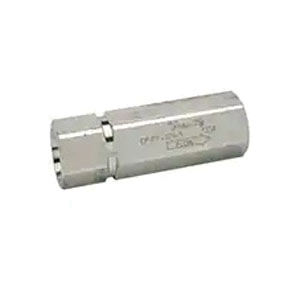CPIFF Series check valves are soft seat, zero leakage poppet check valves with compact one piece construction. Standard crack pressures are 5, 15, 25 and 65 psi. These valves are available in a wide range of sizes up to 1 in, with female fitting ends and flow capacities up to 30 gpm. Basic check valve construction consists of a valve body with an inlet and an outlet port. Inside, a moveable poppet valve is controlled by spring pressure. In most cases the valve is normally closed, opening when the fluid pressure is greater than the spring force (crack pressure), thus allowing the fluid to flow in only one direction. When reverse flow attempts to enter though the outlet the poppet closes and flow through the valve is stopped. Soft seat check valves have an O-ring or similar elastomeric seal between the poppet and body for improved leak resistance. The soft seat design is most compatible with "clean" systems and is not indented for use in systems that have high-surge flow. The seal material dictates the temperature range of the valve.
Parker® Check Valve, Series: CPIFF Series, FNPSF Connection, 3/4 in Nominal Size, 5000 psi Pressure, 20 gpm Flow Rate, Steel Body, Fluorocarbon Seal, Dimensions: 4.33 in L
California residents see Prop 65 WARNINGS
| Body Material | : | Steel |
| Connection Type | : | FNPSF |
| Dimensions | : | 4.33 in L |
| Flow Rate | : | 20 gpm |
| Nominal Size | : | 3/4 in |
| Pressure Rating | : | 5000 psi |
| Seal Material | : | Fluorocarbon |
| Series | : | CPIFF Series |
- Allows the fluid to flow in only one direction, protecting the system from fluid back pressure
- Soft seated valve creates a leak-free seal
- Fluorocarbon seal is standard
- Orifice bore size is determined by application requirements
- Custom shapes and configurations can integrate special features to reduce the number of components and potential leak points in a system
- Ensure hydraulic fluid flows in only one direction
- Eliminate potential damage from back pressure
- Isolate sections of a system or system components




 Instruction/Installation Manual
Instruction/Installation Manual